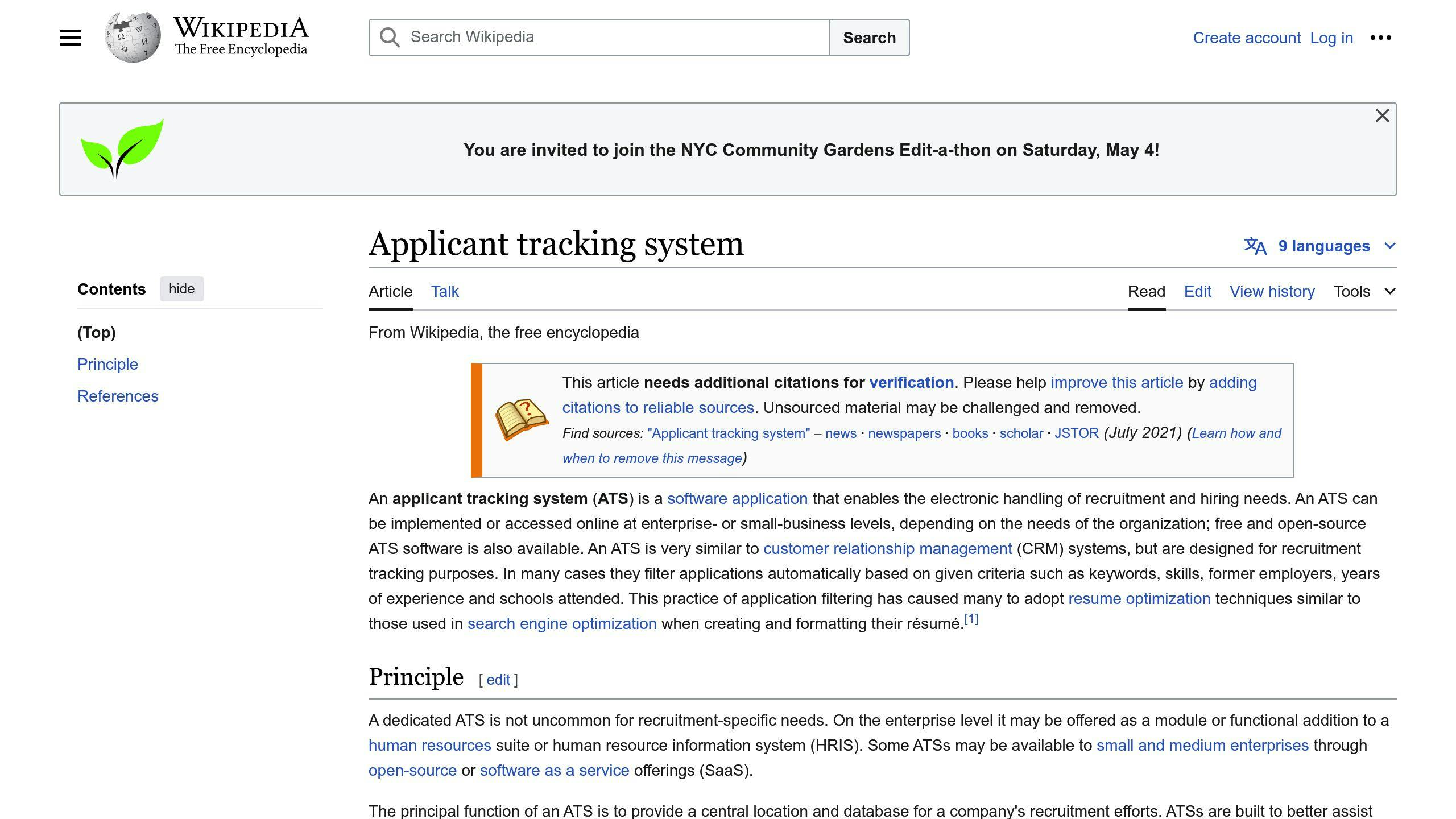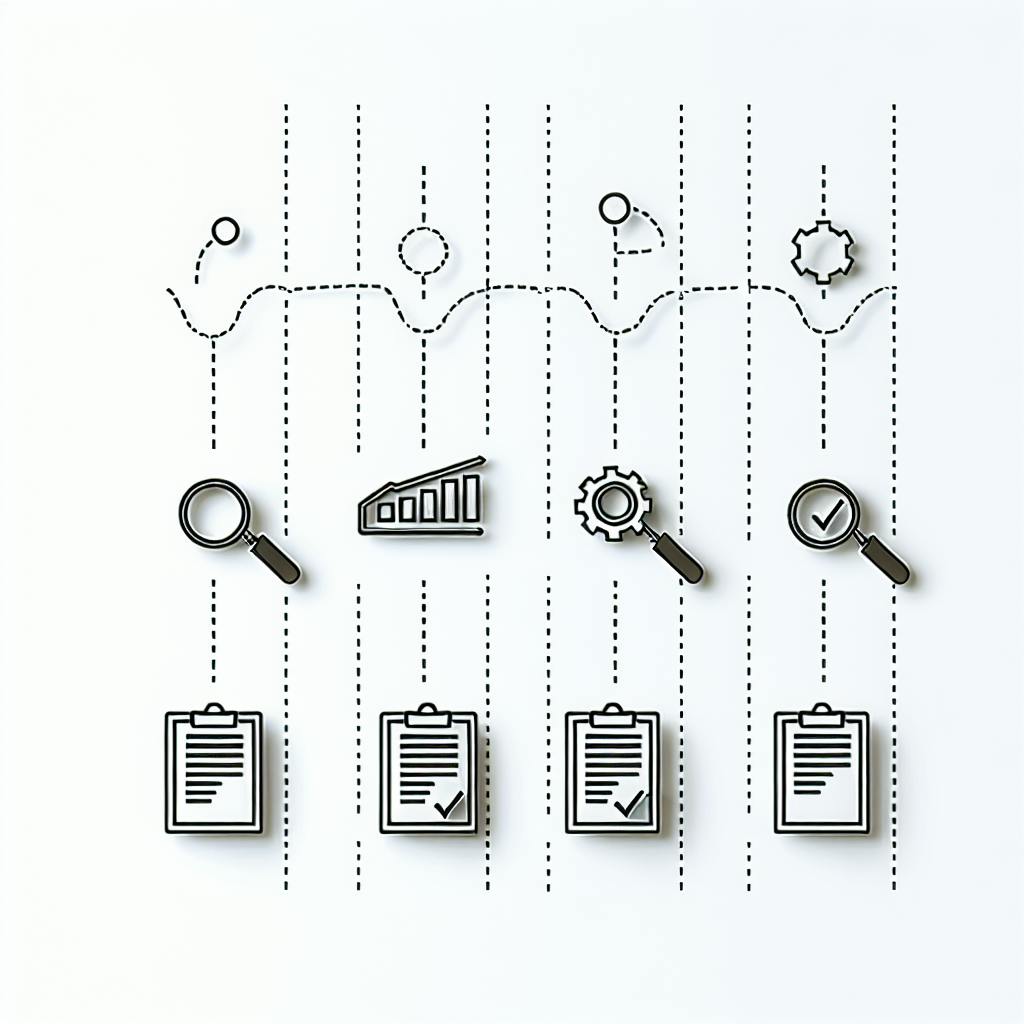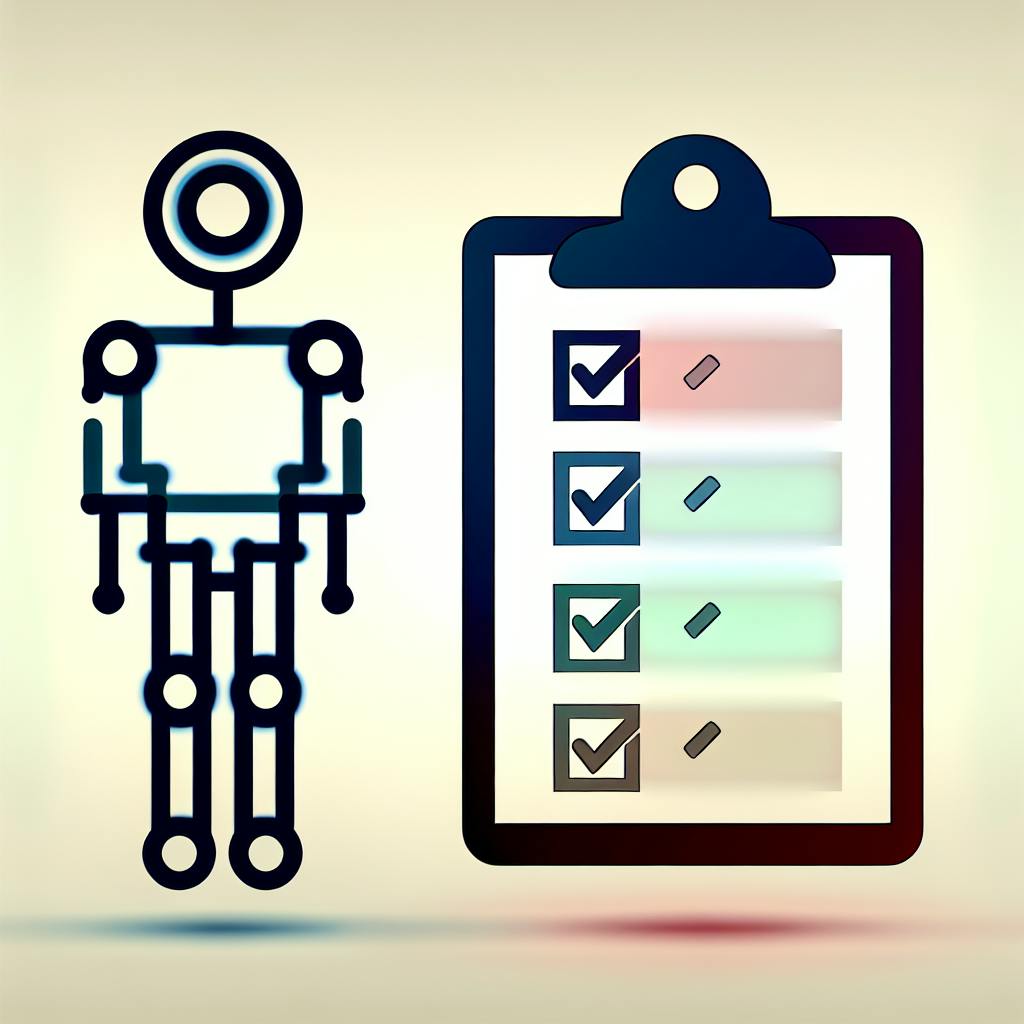Implement a data-driven recruitment strategy to improve hiring outcomes:
-
Choose Relevant Metrics
- Align metrics with hiring goals (e.g., time to hire, cost per hire, quality of hire)
- Track metrics like candidate experience, diversity, and offer acceptance rate
-
Gather and Combine Data
- Use an Applicant Tracking System (ATS) to collect candidate data
- Integrate data from job boards, social media, career sites, and referrals
- Ensure data quality through validation processes
-
Analyze and Understand Data
- Use techniques like data visualization, regression analysis, and recruitment dashboards
- Find patterns, trends, and areas for optimization
-
Improve and Adjust Strategies
- Optimize sourcing channels based on performance metrics
- Streamline application process using completion rates and feedback
- Enhance screening and assessments by evaluating validity and job-relevance
- Continuously monitor metrics, gather feedback, and refine strategies
Benefits of Data-Driven Recruitment:
| Benefit | Description |
|---|---|
| Efficiency | Faster hiring process |
| Quality of Hire | Better job fit and retention |
| Reduced Bias | Increased diversity in hiring |
| Lower Costs | Better return on investment |
| Informed Decisions | Objective, data-backed choices |
| Candidate Experience | Improved candidate satisfaction |
Start leveraging data insights to streamline processes, attract top talent, and build a high-performing workforce.
Related video from YouTube
Step 1: Choose Key Recruitment Metrics
Picking the right metrics is key to measuring your recruitment success. These metrics should match your hiring goals.
Selecting Relevant Metrics
Not all metrics will be important for your organization. Focus on those that align with your hiring needs. For example, if you want to reduce time-to-hire, track "time to fill" and "source of hire." If improving candidate experience is your goal, look at "candidate satisfaction" and "offer acceptance rate."
Common Recruitment Metrics
Here are some common metrics to consider:
| Metric | Description |
|---|---|
| Time to Hire | Days from job posting to accepted offer. |
| Cost per Hire | Total cost of hiring a new employee. |
| Source of Hire | Channels that yielded successful hires. |
| Offer Acceptance Rate | Percentage of accepted job offers. |
| Candidate Experience | Satisfaction of candidates throughout the process. |
| Quality of Hire | Performance and retention of new hires. |
| Diversity and Inclusion | Diversity of your candidate pool and new hires. |
Metrics Based on Goals
Choose metrics that support your goals:
| Goal | Metrics |
|---|---|
| Reduce Time-to-Hire | Time to fill, source of hire, applicant-to-hire ratio |
| Improve Candidate Experience | Candidate satisfaction, offer acceptance rate, candidate drop-off rate |
| Increase Workforce Diversity | Diversity of applicant pool, diversity of new hires |
Tracking and Reporting
Set up a system to track and report your metrics. An applicant tracking system (ATS) can automate this. You can also use spreadsheets or recruitment analytics software.
Using Data for Improvement
Use the data to improve your strategies. Regularly review your metrics to find areas for improvement. For example, if "quality of hire" is low, refine your screening process. If some sourcing channels are underperforming, adjust your recruitment marketing efforts.
Step 2: Gather and Combine Data
Using an Applicant Tracking System

An Applicant Tracking System (ATS) is a key tool for collecting and managing recruitment data. It stores candidate information and tracks their progress through the hiring process. An ATS captures data like source of hire, time to hire, and candidate qualifications, helping you make informed decisions.
Combining Data Sources
To get a full picture of your recruitment efforts, combine data from various sources. Besides your ATS, use data from job boards, social media, career sites, and employee referrals. This helps you see which sourcing channels work best and where you can improve.
Ensuring Data Quality
Accurate data is crucial for making good decisions. Implement processes to ensure data quality, such as regular audits, standardized data entry, and validation checks. Inaccurate data can lead to poor analyses and bad recruitment strategies.
Data Integration Tools
Use tools designed for data integration to simplify the process. These tools can automate data consolidation from multiple sources, reducing manual work and errors. They often include features like data mapping, transformation, and cleansing to ensure consistent data.
Best Practices for Data Collection
To effectively gather and manage recruitment data, follow these best practices:
1. Define data requirements
Identify the data points needed for your recruitment metrics and goals.
2. Establish data governance
Implement policies to maintain data quality, security, and privacy.
3. Automate data collection
Use automation tools to streamline data collection and reduce errors.
4. Regularly review and update
Periodically review your data collection processes and make necessary adjustments.
5. Encourage collaboration
Promote teamwork between recruitment, IT, and data analysts for effective data management.
sbb-itb-32d91a1
Step 3: Analyze and Understand Data
Data Analysis Techniques
To get useful insights from your recruitment data, use these techniques:
| Technique | Description |
|---|---|
| Descriptive Statistics | Calculate metrics like mean, median, and standard deviation to summarize your data. |
| Data Visualization | Use charts, graphs, and dashboards to see trends and correlations. |
| Regression Analysis | Understand relationships between variables, like how sourcing channels affect time-to-hire. |
Using Recruitment Dashboards
Recruitment dashboards give you a clear view of key metrics and visualizations. They help you monitor and understand data easily. Look for tools that offer customization, real-time updates, and collaboration features.
Finding Patterns and Trends
Analyze your data to find patterns and trends. Look for correlations, such as the link between candidate source and job performance. Identify outliers and investigate why they occur. Check data over time to spot trends in metrics like time-to-hire or cost-per-hire.
Analysis Tools
Use these tools to make data analysis easier:
| Tool Type | Examples |
|---|---|
| Spreadsheet Software | Excel, Google Sheets |
| Business Intelligence (BI) Tools | Tableau, Power BI, Qlik |
| Statistical Software | R, SAS, SPSS |
Common Analysis Pitfalls
Avoid these mistakes when analyzing data:
| Pitfall | Description |
|---|---|
| Incomplete or Inaccurate Data | Ensure data quality with governance and validation processes. |
| Biased or Skewed Data | Be aware of potential biases in your data sources or collection methods. |
| Misinterpreting Correlations | Remember that correlation does not imply causation. Investigate further to understand relationships. |
| Overlooking Context | Consider external factors and qualitative insights that may impact your data and analysis. |
Step 4: Improve and Adjust
Optimizing Recruitment Strategies
Use data insights to refine your recruitment strategies:
1. Sourcing
- Analyze metrics like applicant quality, conversion rates, and cost-per-hire.
- Focus on top-performing channels and explore new ones based on data.
2. Screening
- Compare resume screening criteria with quality of hire metrics.
- Adjust criteria to focus on job success predictors.
- Remove ineffective assessment components.
3. Interviewing
- Compare interview scores and feedback with new hire performance.
- Train interviewers on effective, unbiased techniques.
- Adjust interview formats and questions as needed.
4. Selection
- Track new hire performance and retention.
- Adjust selection models and criteria to improve job fit.
Improving Candidate Sourcing
Use data to improve your sourcing strategies:
| Action | Details |
|---|---|
| Analyze Source Performance | Check metrics like applicant volume, quality, conversion rates, and cost-per-hire. |
| Prioritize Top Sources | Focus on the best-performing channels and reallocate budget from underperforming ones. |
| Expand Channels | Explore new sourcing channels and talent pools based on data. |
| Refine Targeting | Use candidate persona data to improve targeting and messaging. |
| Monitor and Adjust | Continuously track source metrics and adjust strategies as needed. |
Streamlining Applications
Make the application process smoother using data insights:
| Action | Details |
|---|---|
| Track Completion Rates | Identify where candidates drop off. |
| Analyze Application Metrics | Check length, complexity, and user experience. |
| Simplify Process | Streamline the application based on findings. |
| Improve Interfaces | Ensure applications are mobile-friendly and user-friendly. |
| Gather Feedback | Use candidate feedback for continuous improvement. |
Enhancing Screening and Assessment
Improve your screening and assessment methods with data:
| Action | Details |
|---|---|
| Evaluate Assessment Validity | Correlate results with job performance metrics. |
| Remove Ineffective Components | Identify and eliminate biased or ineffective parts. |
| Use Job-Relevant Assessments | Implement skills-based assessments aligned with role requirements. |
| Leverage AI | Use AI for efficient, unbiased candidate screening. |
| Monitor Effectiveness | Continuously check assessment effectiveness and update as needed. |
Continuous Monitoring and Adjustments
Create a culture of ongoing improvement:
| Action | Details |
|---|---|
| Review Metrics Regularly | Check recruitment metrics and performance data often. |
| Identify Optimization Areas | Find areas for improvement based on insights and trends. |
| Implement Improvements | Make process changes and monitor their impact. |
| Gather Stakeholder Feedback | Get input from candidates and hiring managers. |
| Refine Strategies | Continuously update strategies based on data analysis. |
Keep learning and adapting. Regularly review your recruitment processes and use data insights to make them better for efficiency, effectiveness, and candidate experience.
Conclusion
Key Points
- Implement a data-driven recruitment strategy in four steps:
- Choose relevant metrics to track (e.g., source of hire, cost per hire, time to hire)
- Gather and combine recruitment data from various sources (ATS, job boards, etc.)
- Analyze data to find insights, patterns, and areas for improvement
- Use data insights to optimize sourcing, screening, interviewing, and selection
- Benefits of data-driven recruitment include:
| Benefit | Description |
|---|---|
| Efficiency | Faster hiring process |
| Quality of Hire | Better job fit |
| Reduced Bias | Increased diversity in hiring |
| Lower Costs | Better ROI |
| Informed Decisions | Objective choices |
| Candidate Experience | Improved satisfaction |
Start Using Data in Recruitment
HR professionals should use data-driven recruitment to improve hiring outcomes. By leveraging data insights, you can streamline processes, reduce costs, attract top talent, and build a high-performing workforce. Start implementing a data-driven strategy today to stay ahead in the recruitment landscape.
| Key Action | Details |
|---|---|
| Choose Metrics | Identify the most relevant metrics aligned with your recruitment goals. |
| Collect Data | Gather data from your ATS, job boards, social media, and other sources. |
| Analyze Insights | Use data analysis tools to find patterns, trends, and optimization areas. |
| Optimize Processes | Refine sourcing, screening, interviewing, and selection based on insights. |
| Monitor and Adjust | Continuously track metrics, gather feedback, and adapt strategies as needed. |
Related posts
- 10 Key Elements of a Compelling Career Site 2024
- 10 Key Employer Branding Metrics to Track in 2024
- AI in Talent Acquisition: Streamlining Hiring 2024




